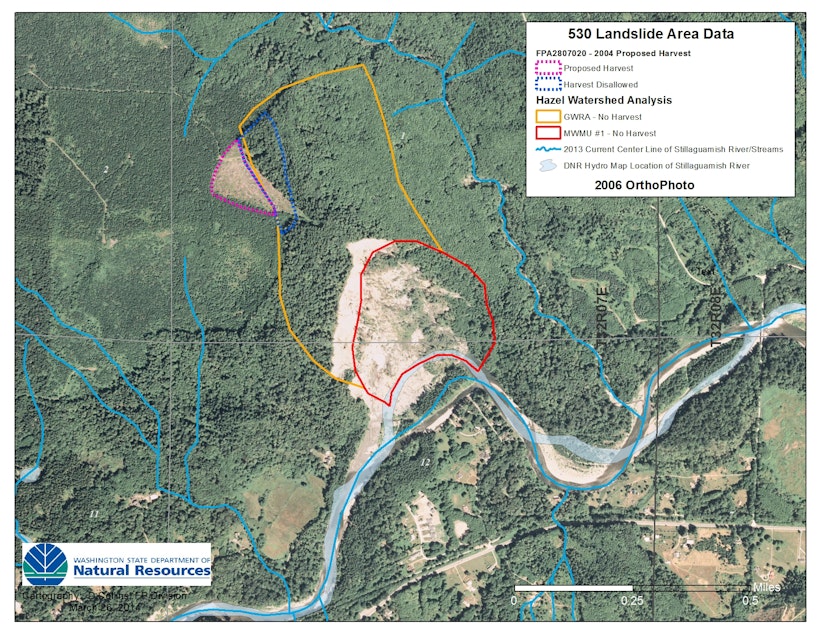Clear-Cut Crossed Into No-Logging Zone In Oso

State officials say they didn't approve clear-cutting inside a no-logging zone directly above Saturday's deadly landslide that struck the town of Oso. But aerial photos show a clear-cut extending into the zone where a loss of trees would heighten the risk of landslides.
Removing forest cover can increase the amount of rainwater that finds its way underground. Geologists say the extra groundwater can destabilize the already unstable soils deep beneath landslide zones.
Records obtained by the Seattle Times and by KUOW show that a clear-cut in 2004 did take out trees inside that zone for the Oso slide. The question that remains is whether the Department of Natural Resources approved cutting where it shouldn't have, or whether the land owner, Grandy Lake Forest Associates of Mount Vernon, cut beyond the boundaries approved by DNR.
Grandy Lake manager Ken Osborn could not be reached for comment.
In 2004, Grandy Lake proposed a 15-acre clear-cut at the upper edge of the Oso landslide zone.
Sponsored
"We rejected that application," Washington State Forester Aaron Everett said. "The one that was approved in the end eliminated the part of the harvest that would have been inside the groundwater recharge area."
On Wednesday, Everett told KUOW that the resulting 7-acre harvest, also known as a clear-cut, went right up to the edge of the groundwater danger zone. "It is right outside the area that is essentially prohibited from harvest at the head of the landslide," he said.
On Thursday, Everett and his boss at the Department of Natural Resources, Washington Lands Commissioner Peter Goldmark, declined to be interviewed. But their agency did release aerial photos showing a clear-cut, shaped like a 7-acre slice of pizza, crossing over the edge of the official no-cutting zone.
The zone where it's officially unsafe to log might not be the same as where it's actually unsafe.
Without drilling wells deep into the earth, geologists can only make educated guesses how groundwater moves. Geologist Paul Kennard, who worked on the Oso site for the Tulalip Tribes in the 1990s, said nobody has drilled wells there. So it's impossible, he said, to specify precisely which plots of land would funnel water beneath the landslide zone and make it more prone to slumping downhill.
Sponsored
"Since the groundwater recharge to the actual landslide has been changing and getting bigger over time, it's a bad idea to harvest right up to the edge of the current groundwater recharge area, especially if that is based on incomplete knowledge," Kennard said.
Seattle geologist Dan Miller conducted studies that led to DNR's delineation of the no-harvest zone at the Oso landslide site. "The extent is very uncertain," Miller said. "It’s just a coarse approximation."
DNR categorized the instability of the ground below the clear-cut site as "indeterminate," or unknown.
Miller said it was unlikely that just a 7-acre clear-cut could trigger the 400-acre slide that destroyed the Steelhead Drive community on Saturday.
"The real culprit must be the incredible amount of rainfall that occurred," Miller said.
Sponsored
Much larger clear-cuts were carved out of the forests above the slide in the 1980s. Geologists say it can take decades for the recovering forest to keep as much rain water out of the ground as the older forest once did.
Editor’s note: An earlier version of this story stated that land above the Oso landslide zone was logged in 2005. The site was logged in 2004 and replanted in 2005.

